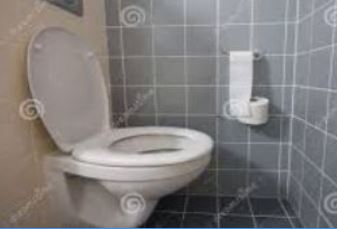


The most modern type of latrine but which needs to have enough water.
The toilet disposal system is provided with a water seal (siphon : inverted U shaped tube) which is always partially filled with water, thereby preventing odours and insects (flies, mosquitoes) from rising from the pit into the latrine. This seal can be part of the bowl or be connected to it immediately below. The bowl is rinsed by water being poured into it after use. This can be done manually using a bucket or a jug filled from a tap or a well (or some other water source). When toilets are supplied by a water system, they can be provided with a tank with a float valve, which fills up automatically after each flush.
Manual flush systems are mainly used in rural or suburban areas where, in most cases, there is no sewer system. The mechanical flush system is widely used in developed countries and in urban or suburban areas of large towns in developing countries where water supply and wastewater management infrastructures are available or can be feasibly provided. This method is also used in public places such as schools or public latrines as it provides greater comfort and better hygiene.
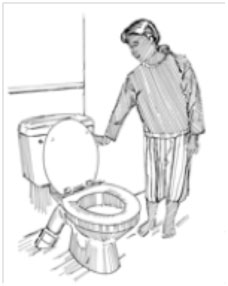 3) Why ?
3) Why ?It is an important step forward in terms of comfort, hygiene and the environment. Those latrines are ideal for people who use water for anal cleansing.
This method concerns the populations of developed countries as well as developing countries, which are gradually upgrading their sanitation systems. Flush toilets can only be used in regions where water is available in sufficient quantities.
Manual flush toilets usually consist of a "squat" slab with a siphon.
The slabs of mechanical flush toilets can be of the "squat" type or fitted with a seat. Both processes can be connected to a pit or a sewer system. Although pits can be built under the slab, the process allows pits to be offset relative to the bowl.
The figure below shows a bowl and a siphon for a so-called "flush offset" latrine
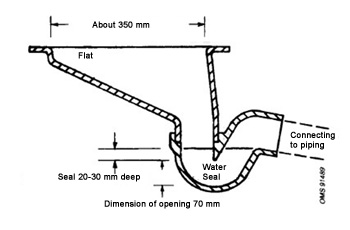
In self-sufficient systems, flushing is usually the result of a current strong enough to expel the faeces through the water seal. The amount of water needed depends on the geometry of the bowl or base, the depth and volume of the water seal and the minimum cross-section through the seal. For a seal located directly above the pit, about a litre of water should be enough for flushing. At least two litres are needed if the pit is offset and three litres for an advanced bowl with a base and an offset pit.
The siphon can be connected to an offset pit by means of an ordinary pipe or a covered ditch. The pipe, or ditch, should be at least 75 mm wide and should be as straight and as smooth as possible. Ordinary cheap pipes are perfectly suitable, whether made of clay, plastic or fibre cement. The minimum slope is 1 in 30 for smooth pipes and 1 in 15 for rough pipes or hand-dug ditches. When the pipe is fed through the wall of a superstructure, special precautions should be taken
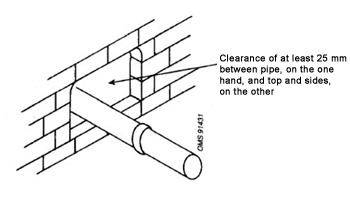
It is not advisable to remove the water seal in the dry season to reduce water consumption. Indeed, it is likely that users will not put the siphon back at the start of the rainy season. As a result, the toilet will not work properly.
In addition, the choice of materials is very important as good compromise needs to be found between reasonable cost and good system service life. Ceramic, white earthenware and glazed pottery are materials that are traditionally used for bowls and bases. Unfortunately, these items can be expensive to purchase and need to be packed carefully for safe transport. In most cases, they are also heavy and call for reinforced slabs for direct fall pits. This problem, together with the problem of handling and transportation, mean that the use of plastics may be a good solution, in spite of their higher price. Reinforced fibreglass bowls and high density polyethylene (HDPE) siphons are lightweight and easy to carry, even on a bicycle.
The cheapest bowls and siphons are those made from cement mortar (10 to 30 mm thick) near points of sale or delivery. These parts can, however, be produced on a large scale without industrial plants and local populations can easily repair damaged parts. The products obtained are, in most cases, less smooth than those produced by industry. Furthermore, a reaction between urine and cement results in the appearance of stains on surfaces and odours at the exit of siphons. These defects can be overcome by adding dust and marble chips to the mortar. The surface should then be rubbed with a polishing stone.
- Relatively cheap in many countries (starting at €60, for example, in France for a complete porcelain assembly).
- No smell, flies or mosquitoes.
- User comfort.
- Can be used inside a home.
- 2 to 3 litres of water are usually enough for a manual flush.
- Need for a good source of water nearby.
- The siphon can easily become clogged.
- The use of solid products for anal cleansing (such as sawdust for dry toilets) is not recommended (except for thin paper).
The investment cost is about €50 to 100 for a manual flush system and about €100 to 200 for a mechanical flush system. The operating cost varies according to the price of water which to which maintenance costs should be added.
This technology is not intended for grey water. The pouring of large quantities of water is not recommended.
When sizing pits, it is important to know the approximate predictable amount of human waste. The usual average figure taken is 1 litre of total excreta (faeces + urine) per person per day. The volume of such excreta and resulting waste is reduced differently over time depending on whether the pit is dry or wet (=> waste). A family of 5 or 6 people, using toilet paper, will thus fill its latrine at a rate of about 0.5 m3 per year.
In cases where a sewer system was not available, the design of siphon-type flush latrines resulted in the development of offset-pit type flush latrines outside the perimeter of the stall, as shown in the diagram below.
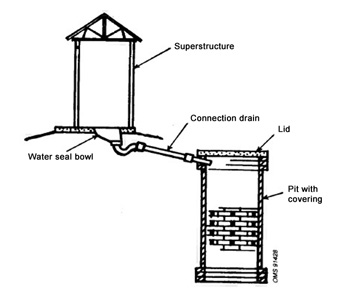
The contents of the bowl are evacuated by a small diameter drain tube or by a covered channel, with a slope of at least 1 in 30. Although the drain can be provided by a 10 cm diameter PVC, cement or clay tube, this diameter can also be the same diameter as the water seal (65-85 mm). A masonry or terracotta channel can also be produced, with a rounded, smooth base slab covered by moulded plates made of cement or terracotta.
The channels and tubular drains should penetrate at least 10 cm into the pit to ensure that the effluent does not erode the pit wall. Latrines with an offset pit require more flush water than a latrine with an ordinary flush. The quantity of water depends on the bowl shape and the drain slope and roughness. Although various works indicate a figure of 1.5 litres as the volume of water needed, a much larger volume needs to be used in reality. Offset pit latrines are often preferred to other types as the stall is built on a permanent basis. Once the pit is filled, another pit is dug alongside, the evacuation drain is dug up and refitted for the new pit without damaging the superstructure.
The other big advantage of this system lies in the fact that the toilet can be installed in the house with a pit outside. When this solution is used, care should be taken to ensure that the drain pipe can move, either by providing an opening in the outside wall so that it does not bear on the pipe, or by using two lengths of pipe connected in the middle the wall. Both systems allow relative movement without any risk of breaking the pipe.
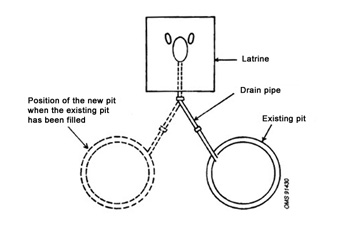
- WHO : "Individual sanitation guide" is a very comprehensive and detailed 251-page guide on all individual sewage disposal systems. In particular, see pages 129 to 133.
http://www.bvsde.paho.org/bvsacd/wh...
- IOWater (International Office for Water) - French language network : RéFEA : 4-page fact sheet on building the siphon and connecting a, offset-type flush toilet
http://www.oieau.fr/ReFEA/fiches/El...